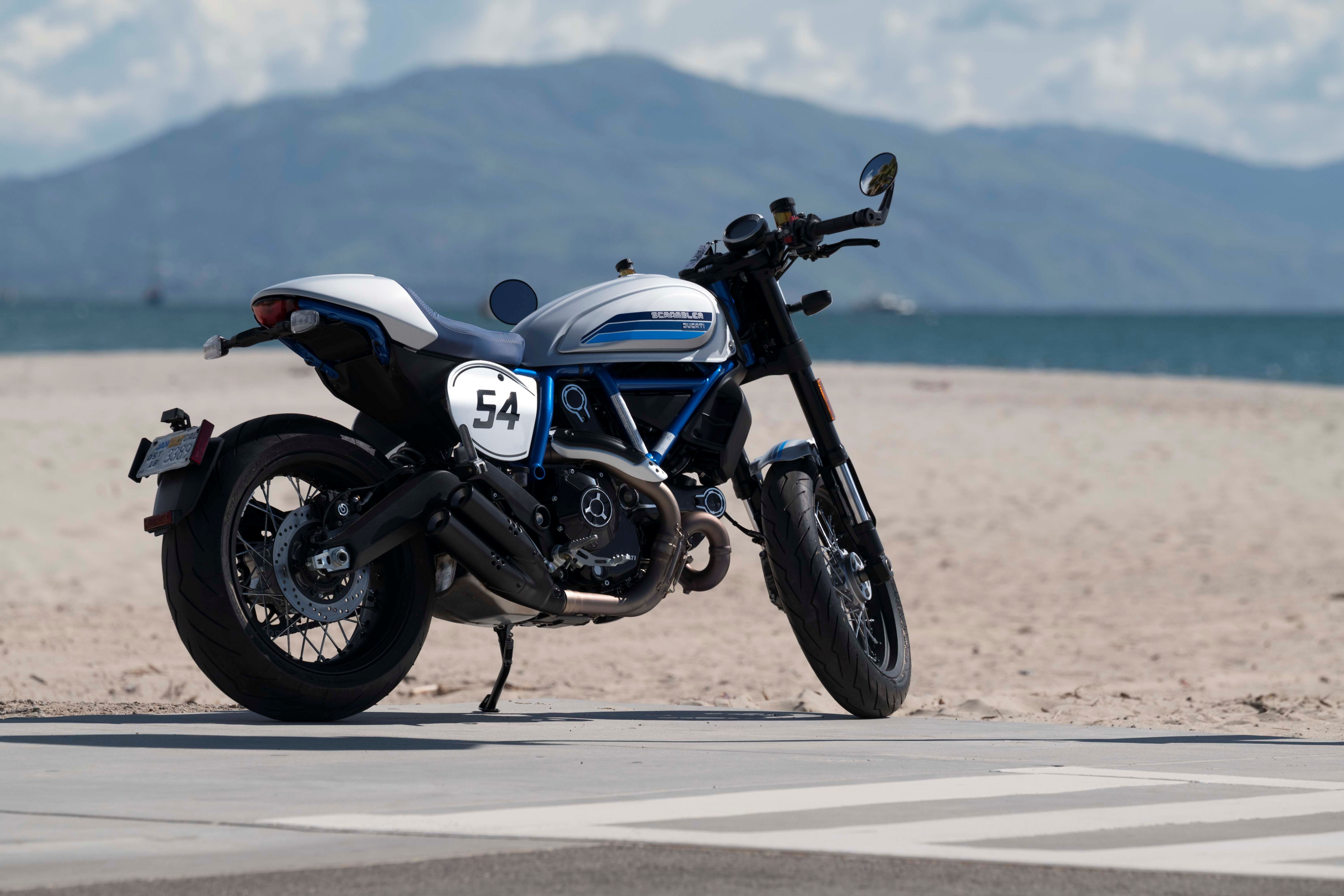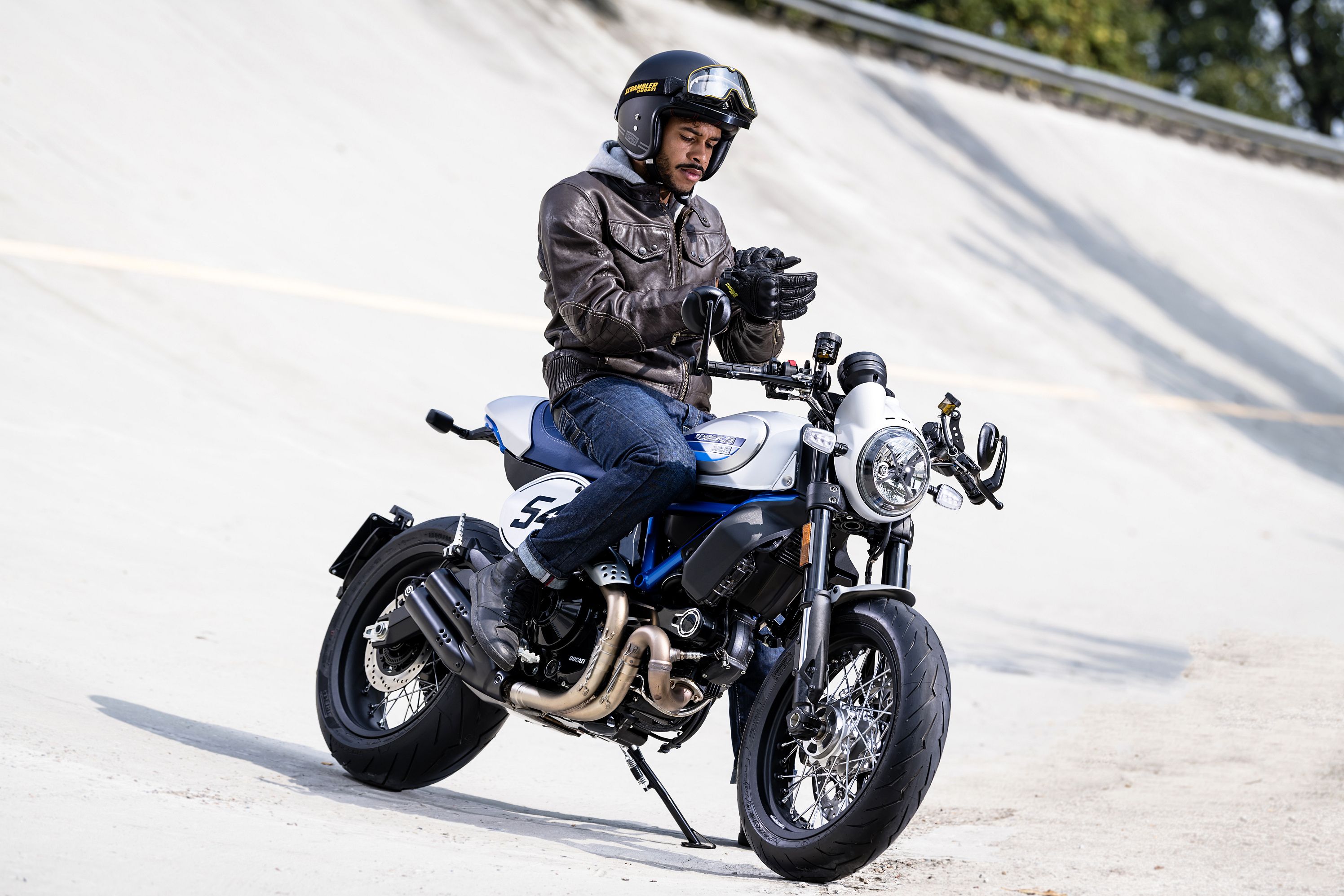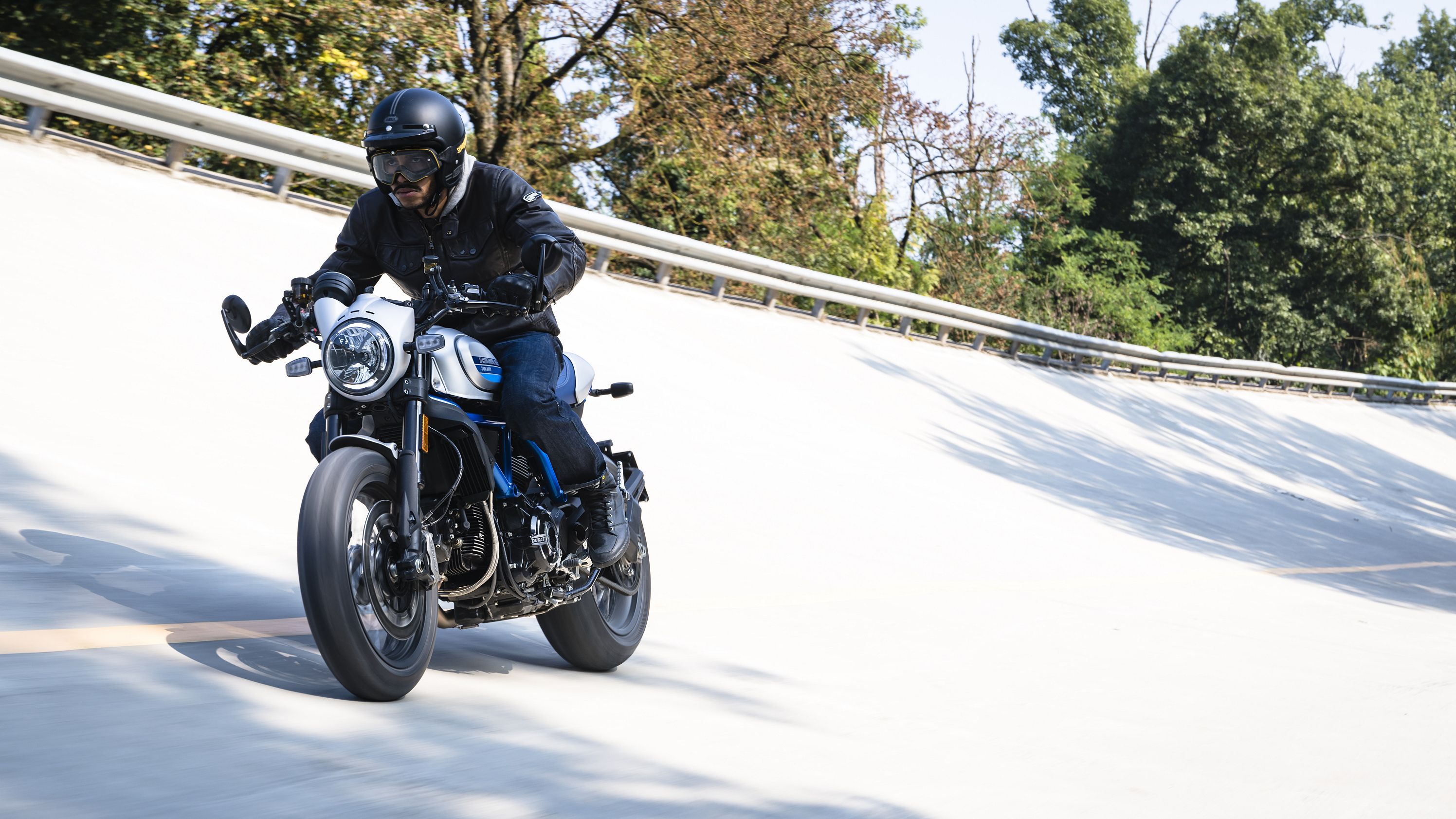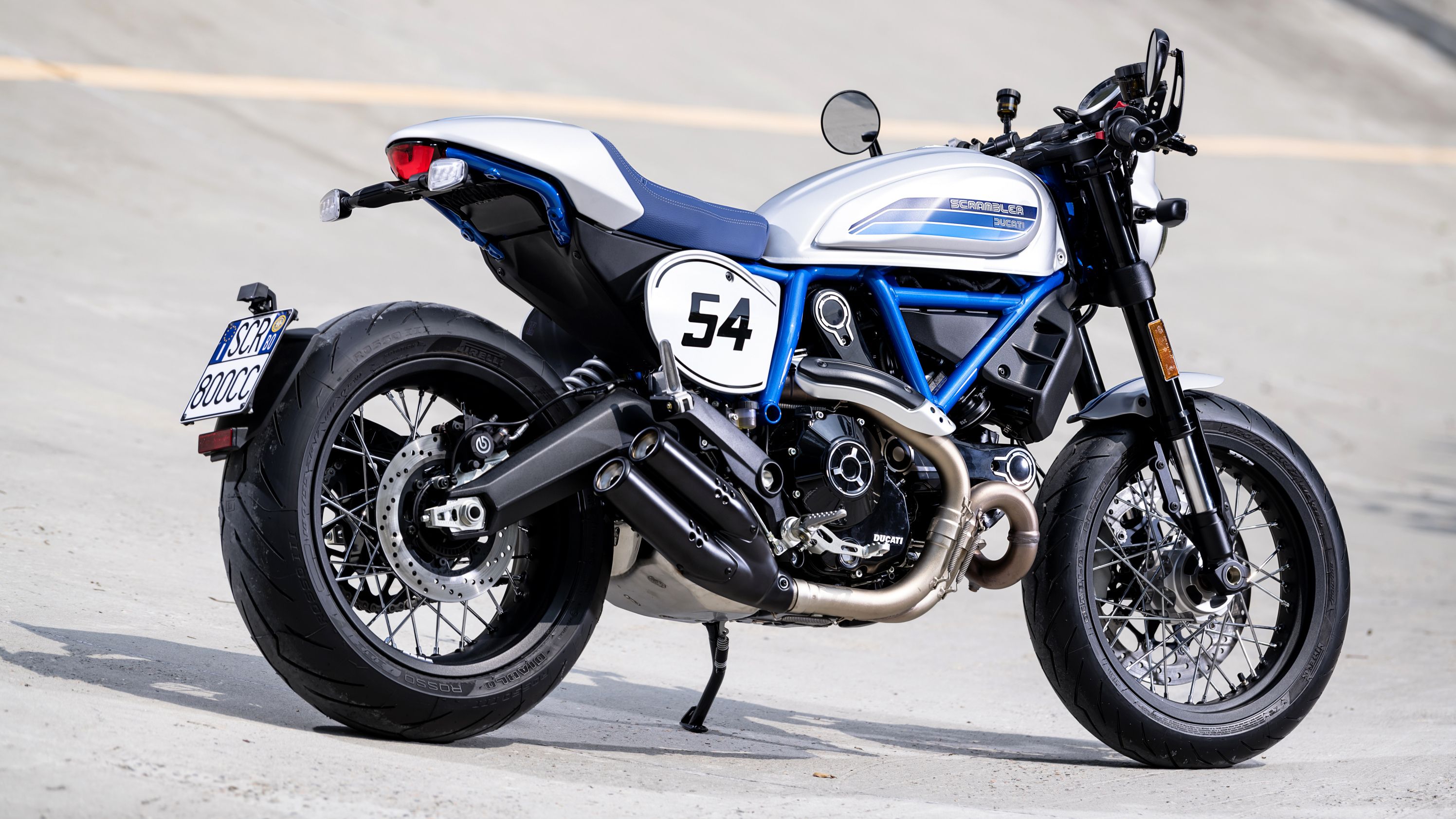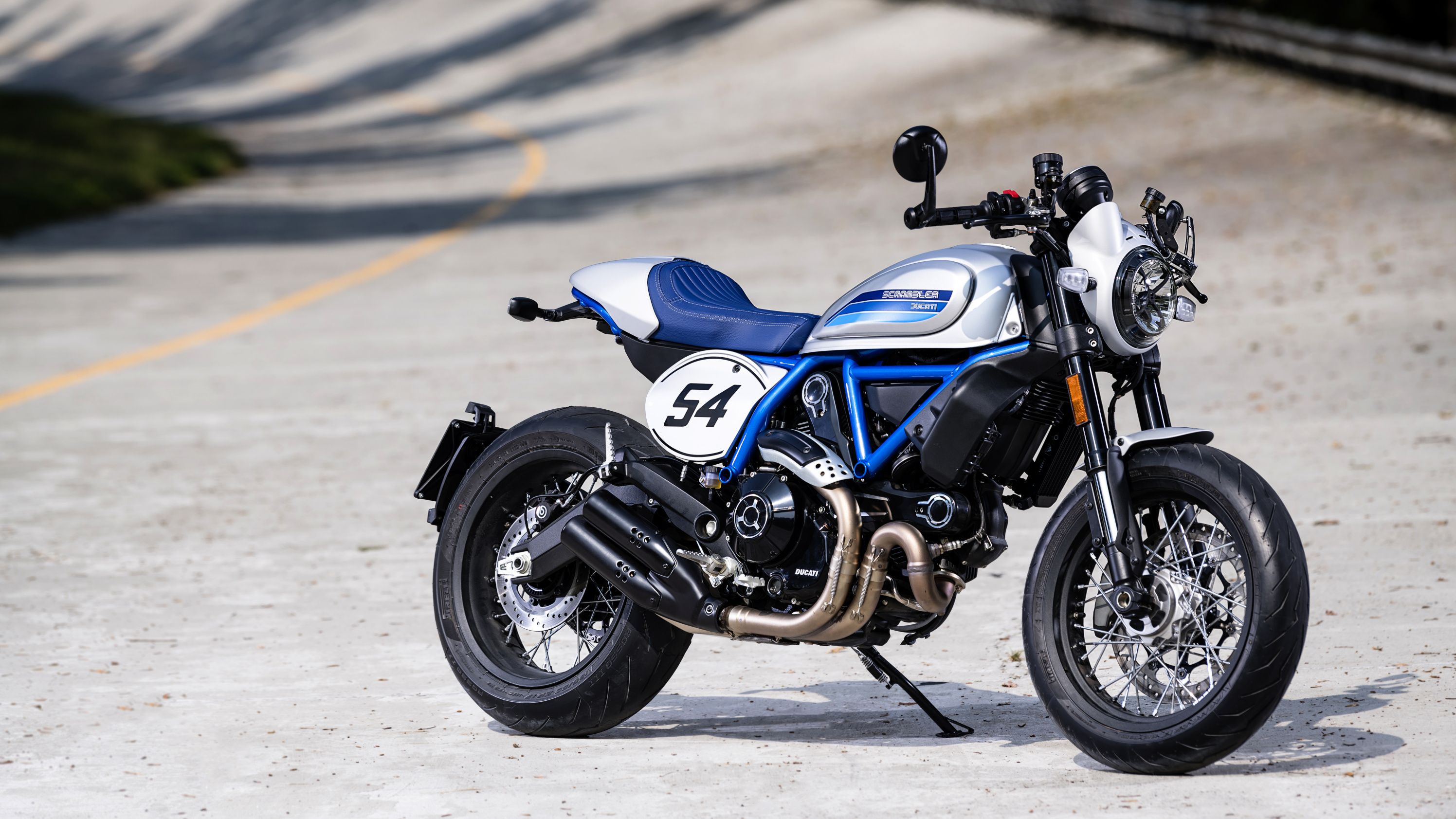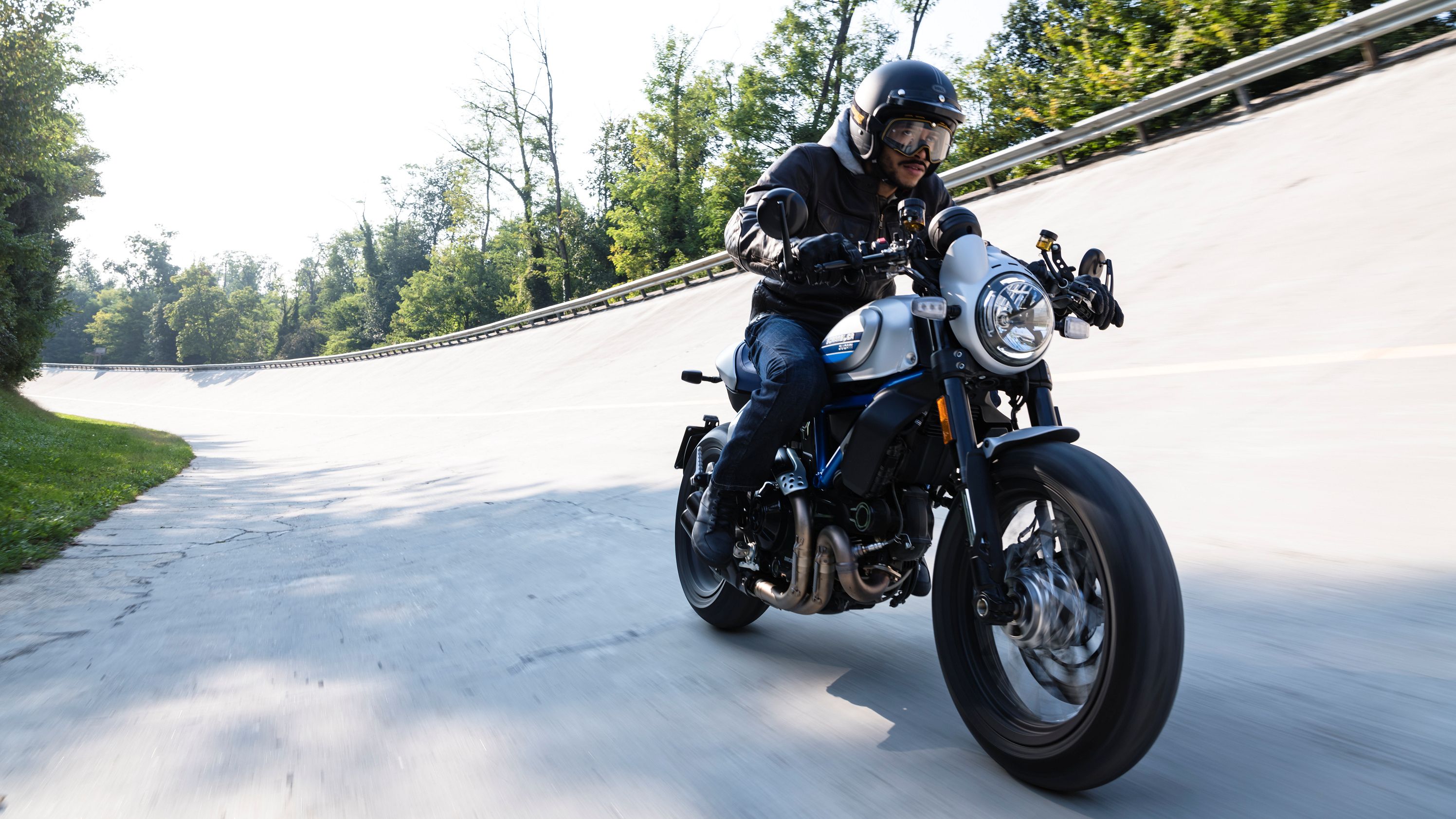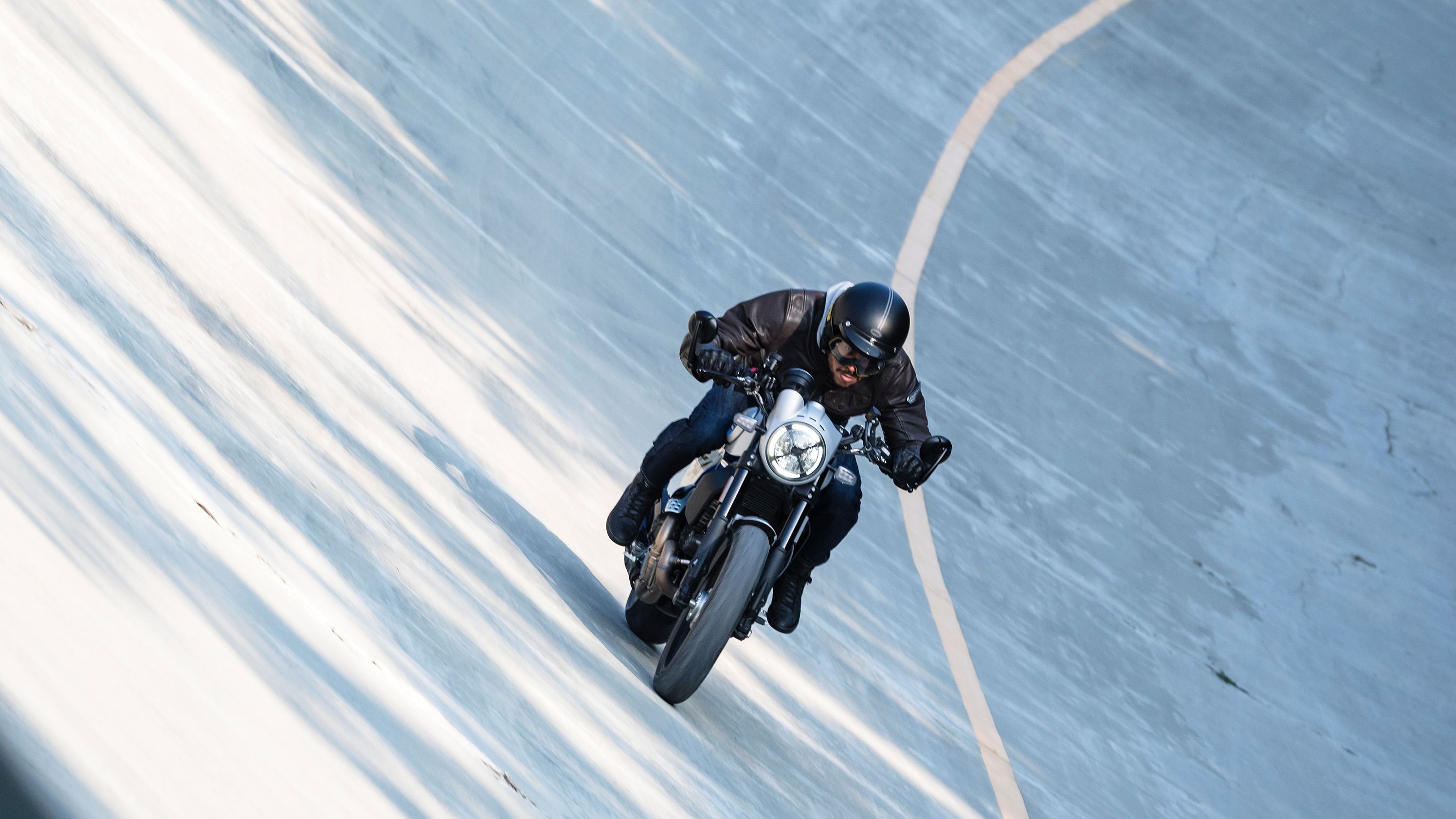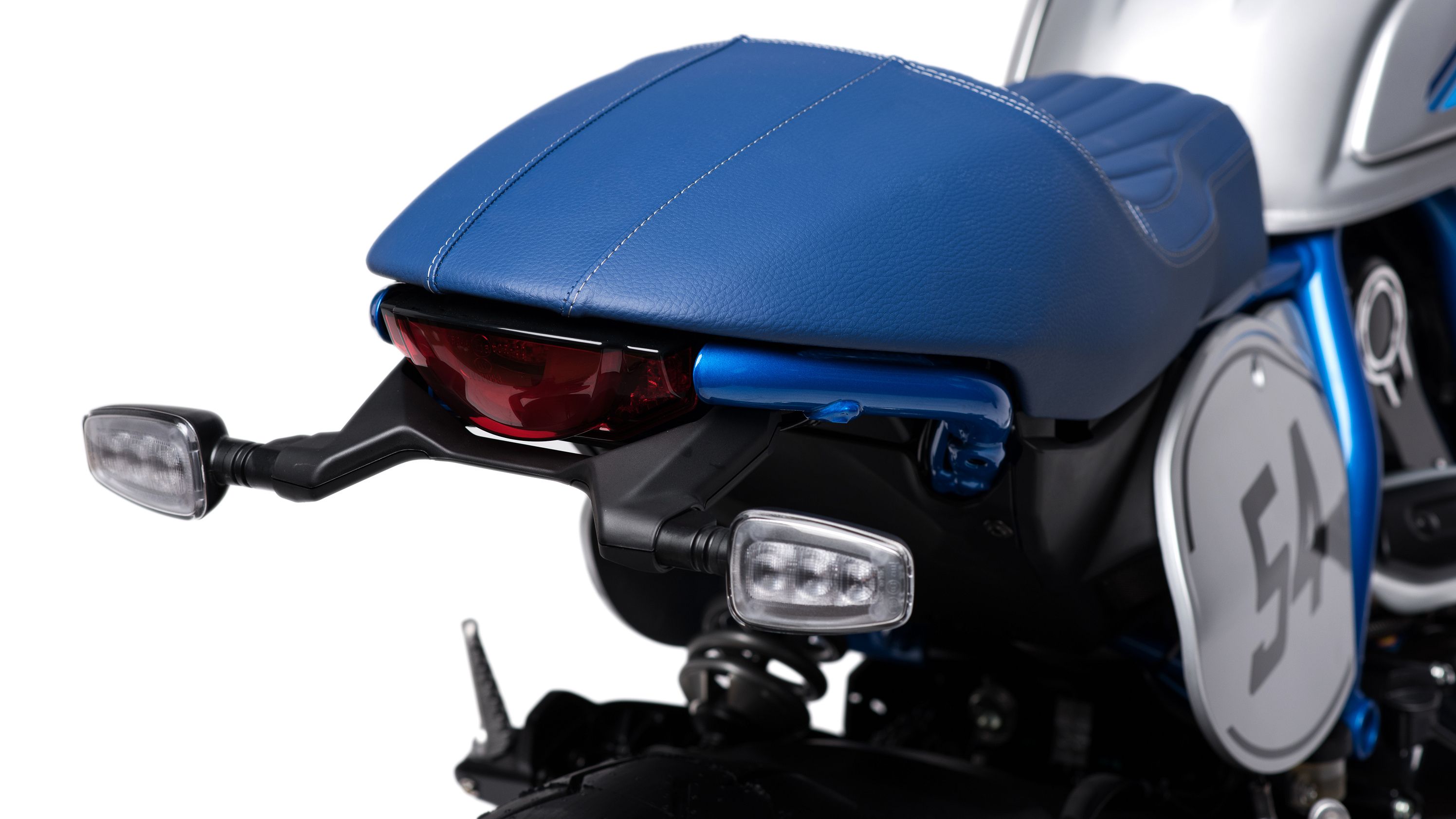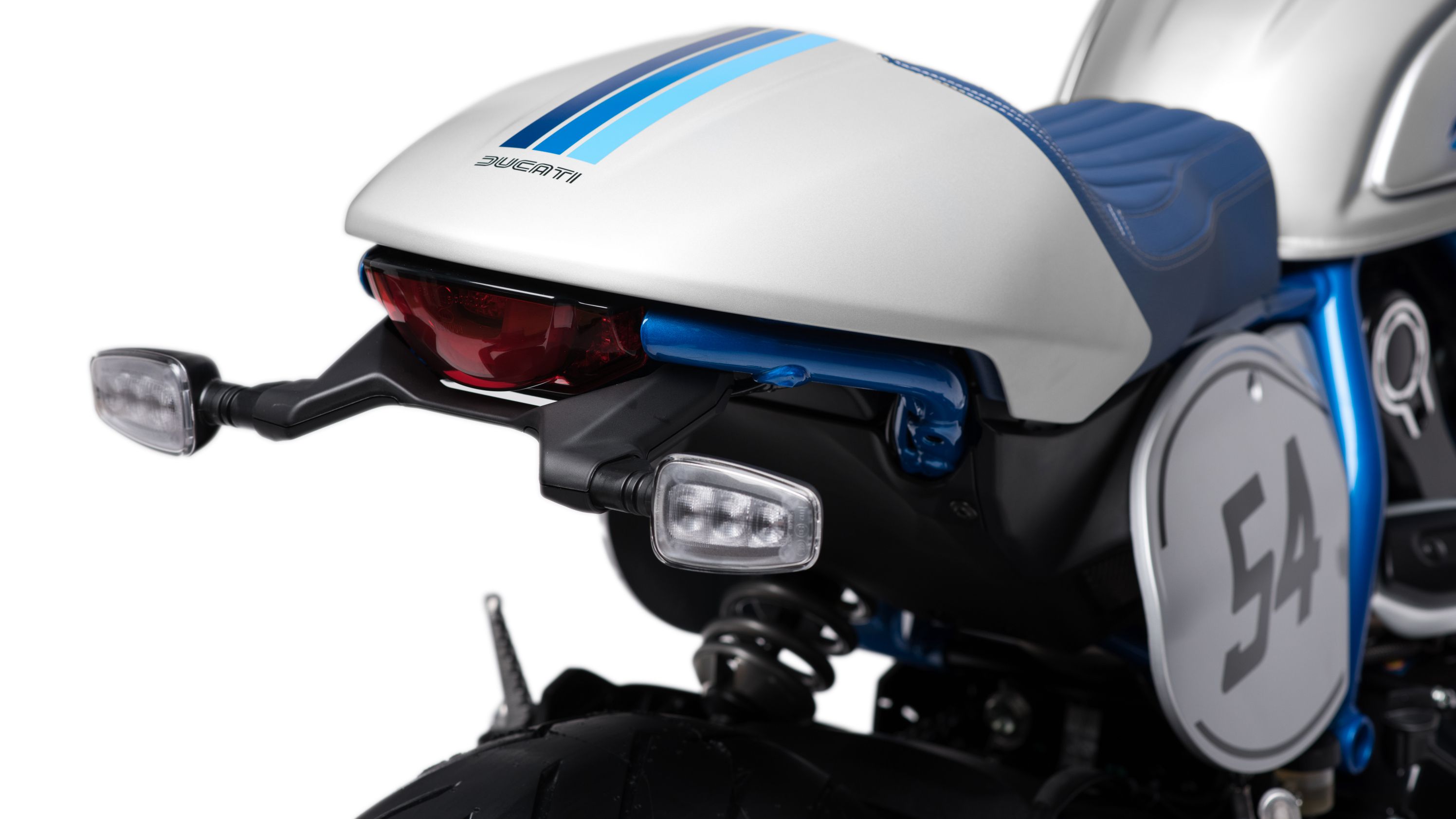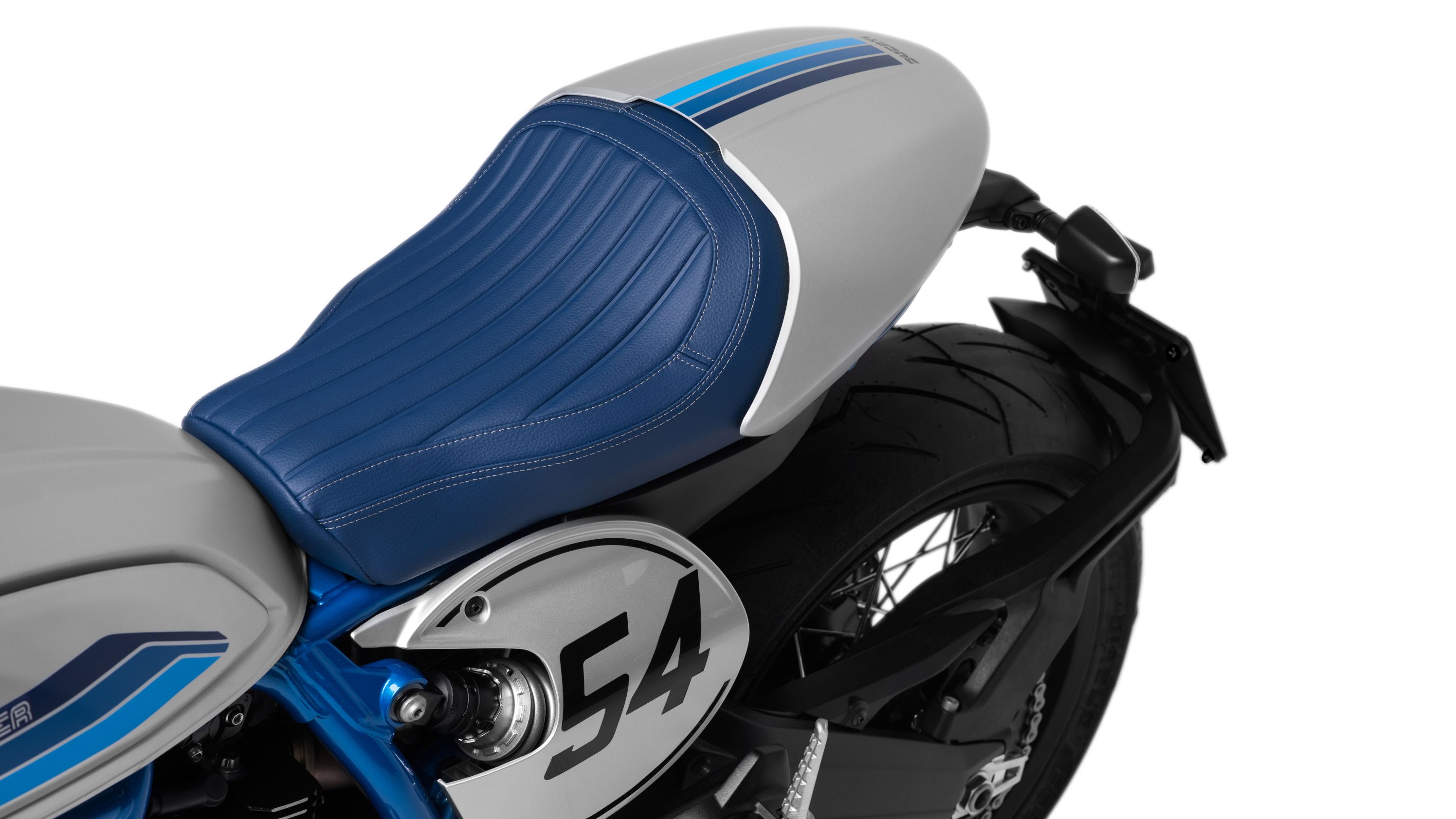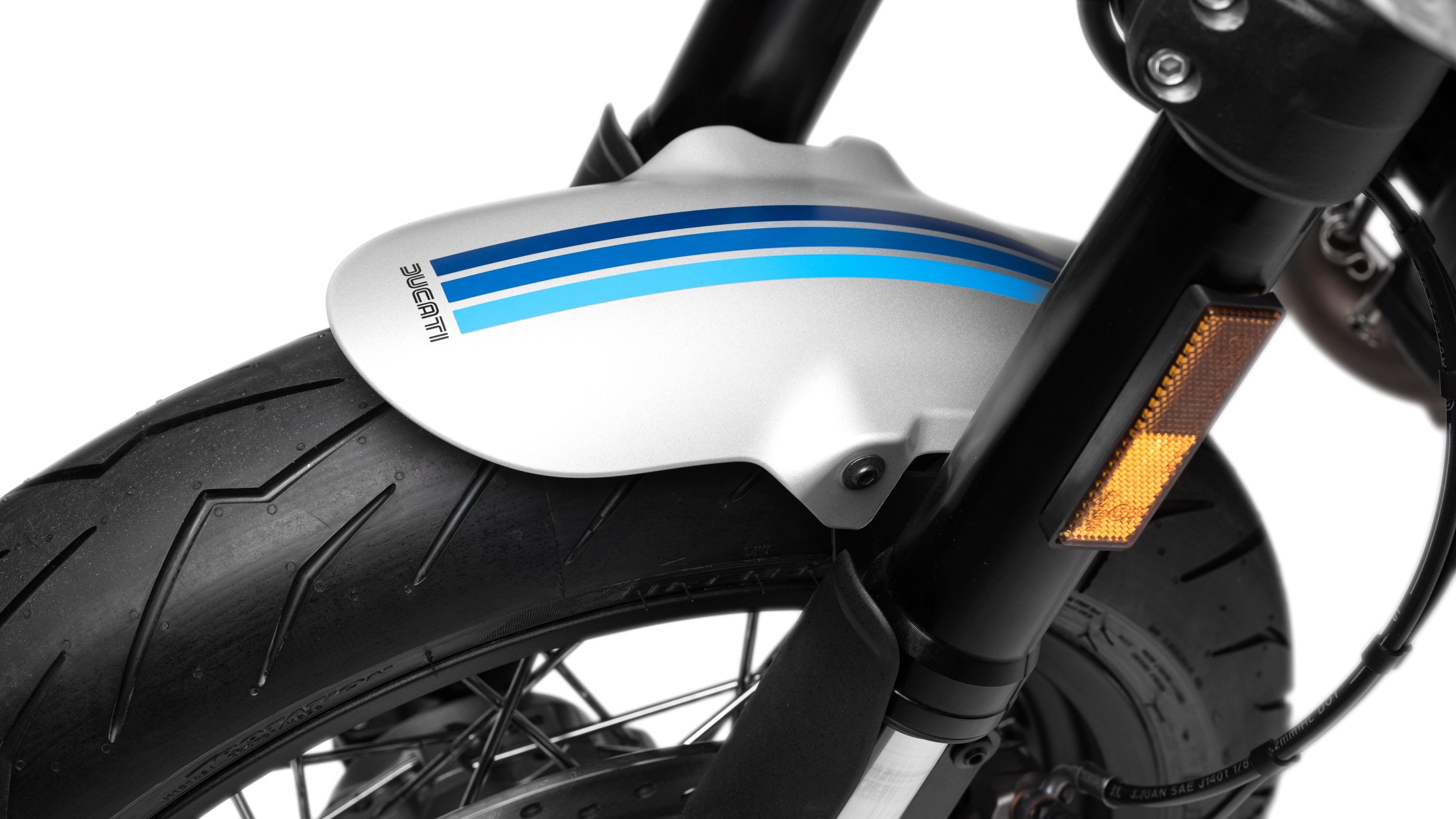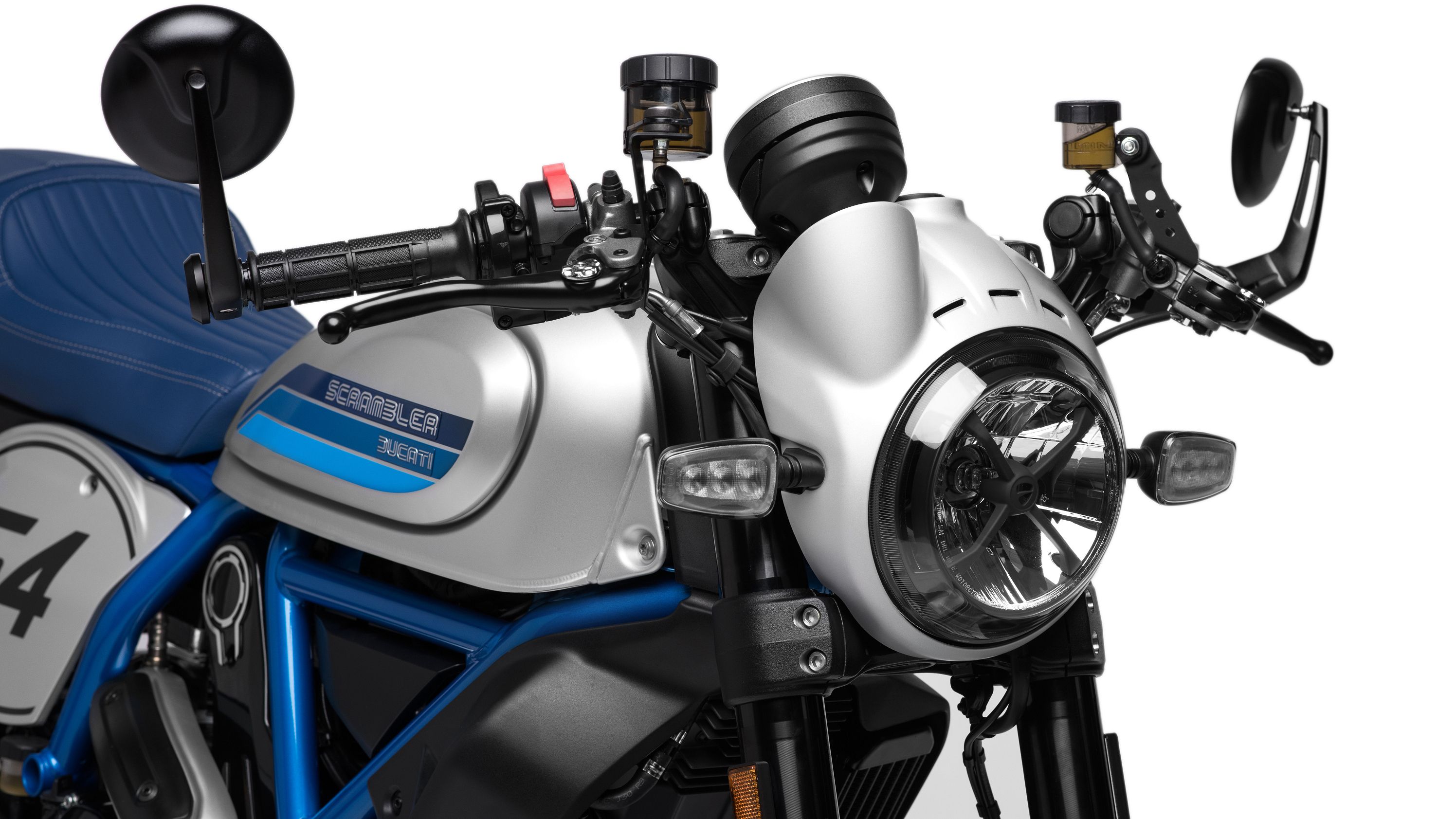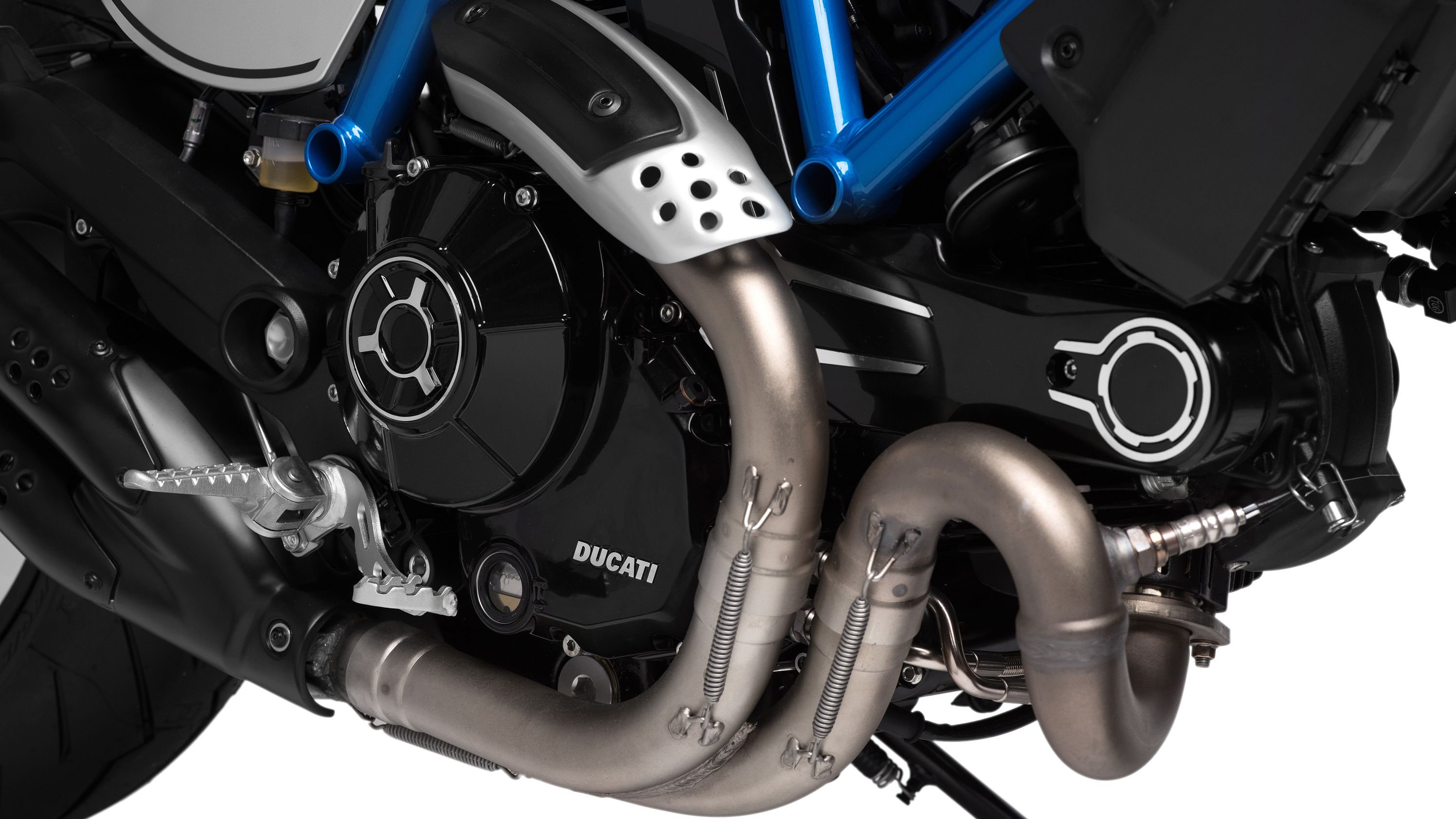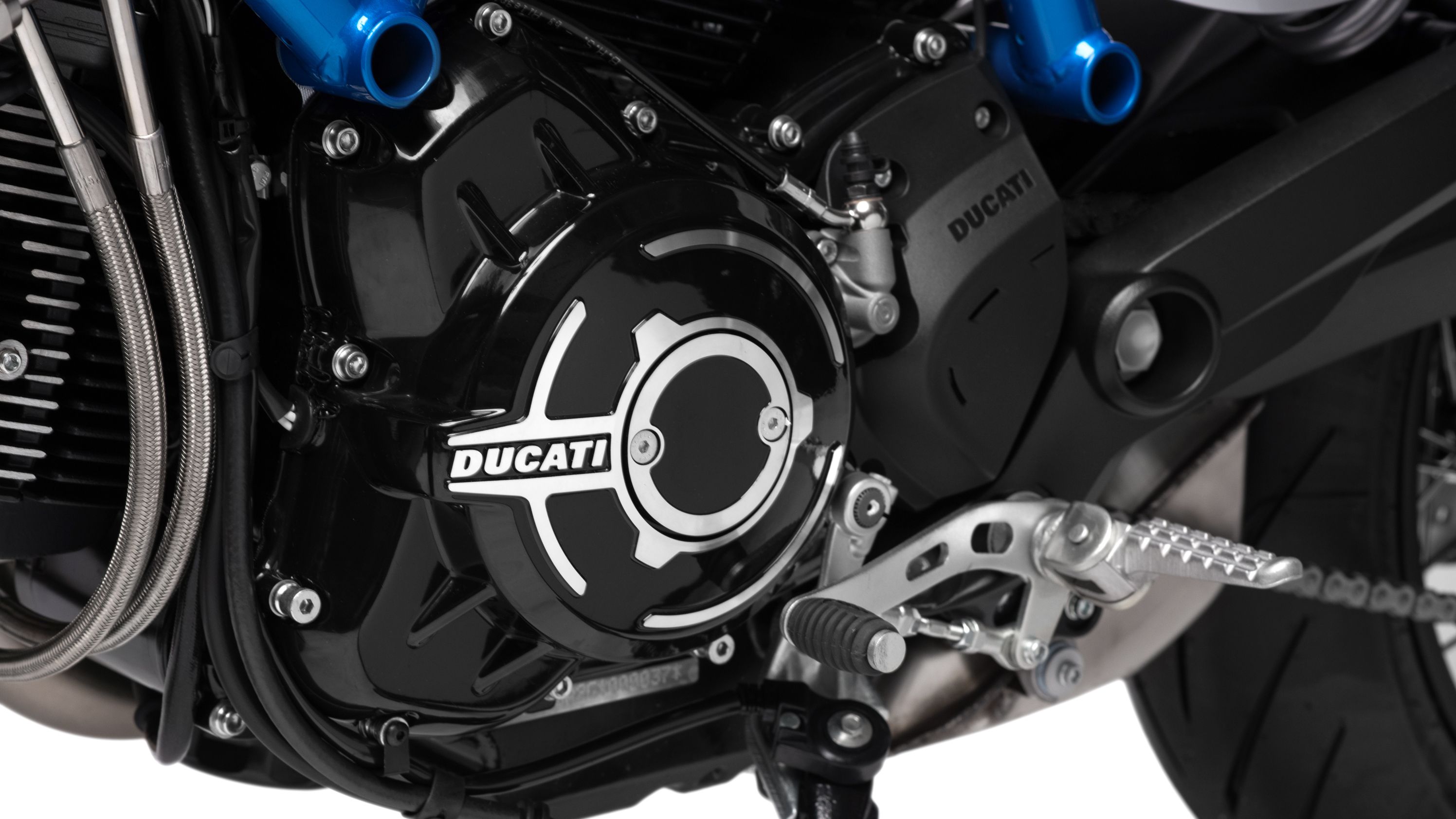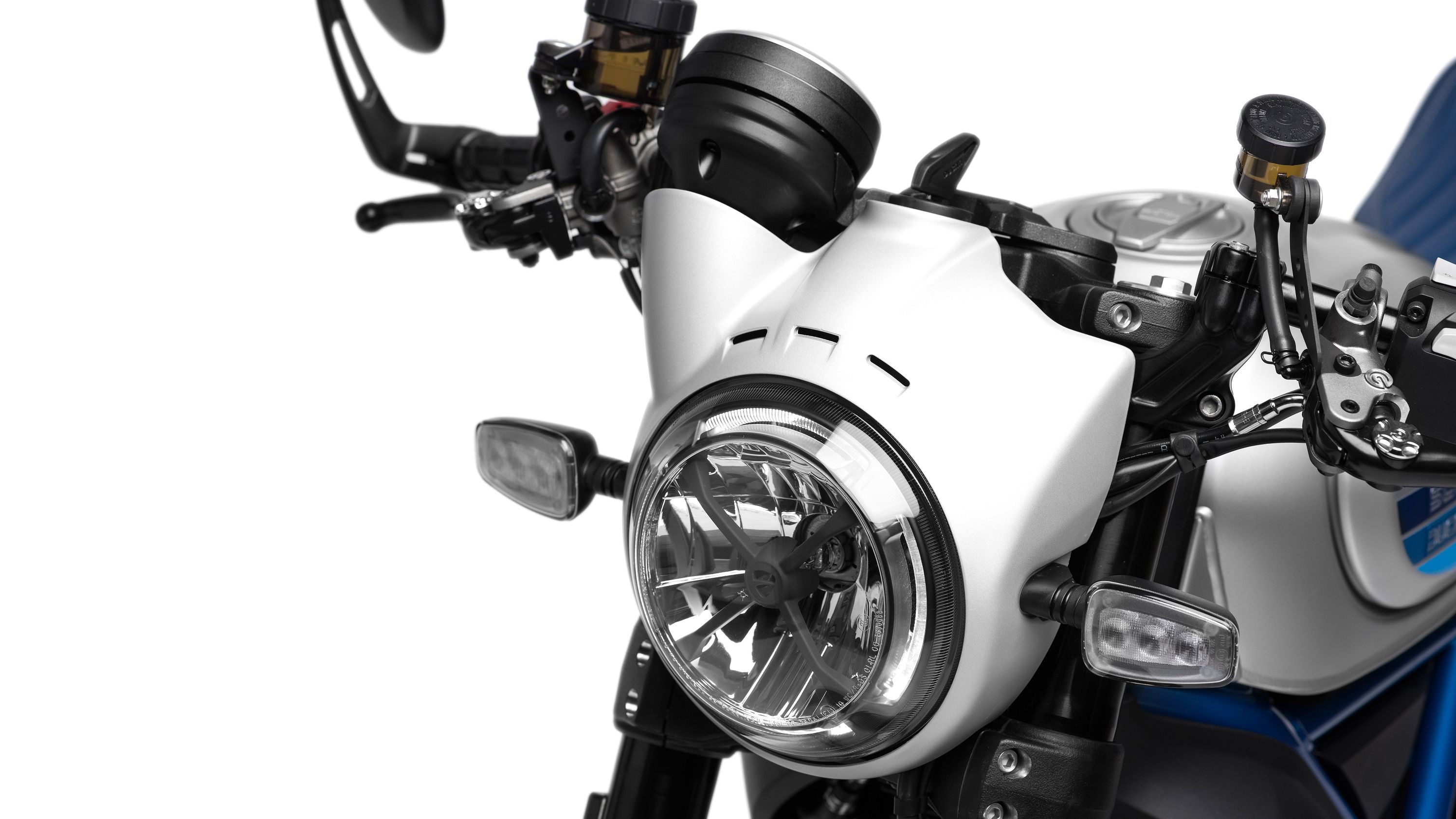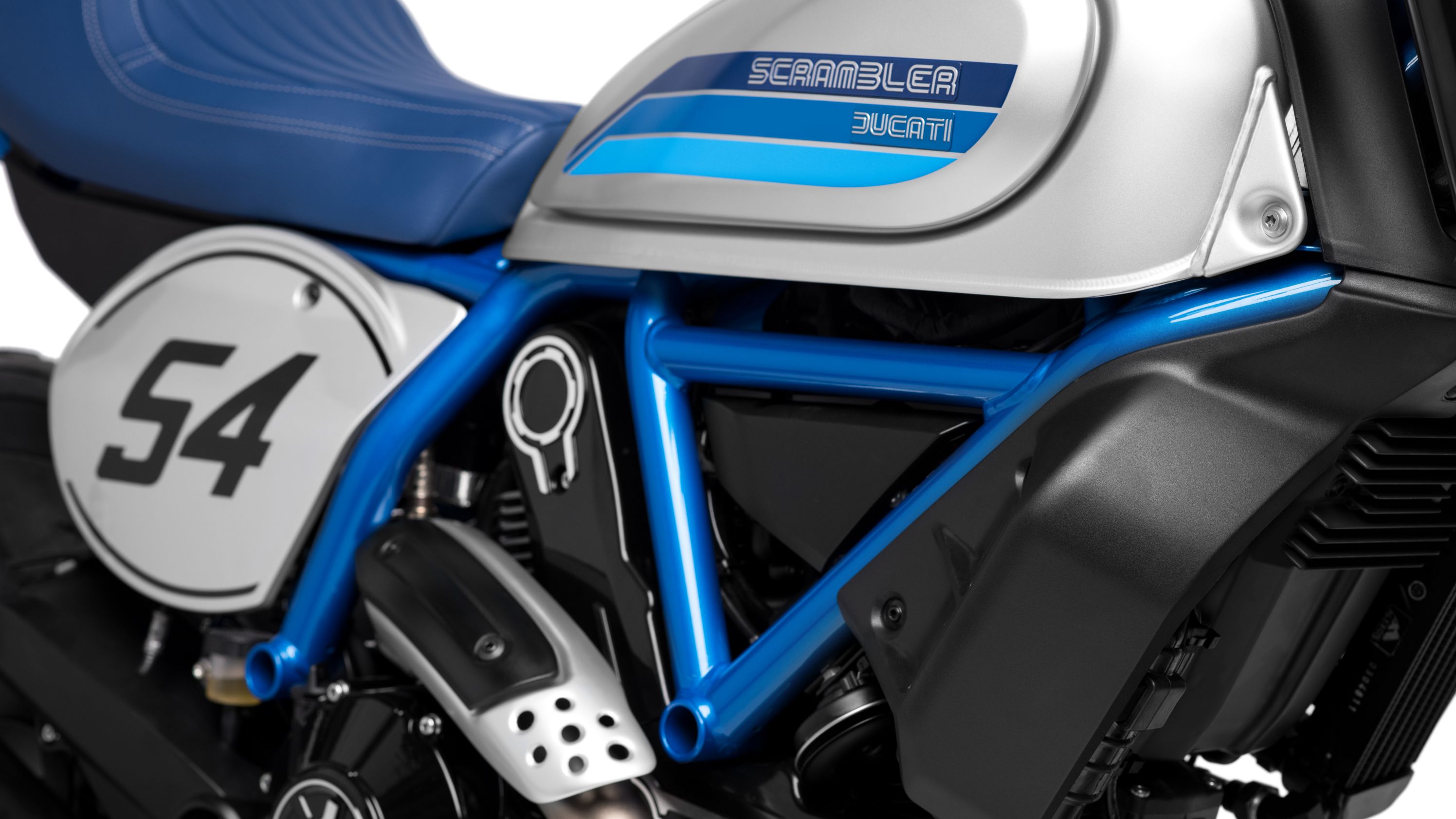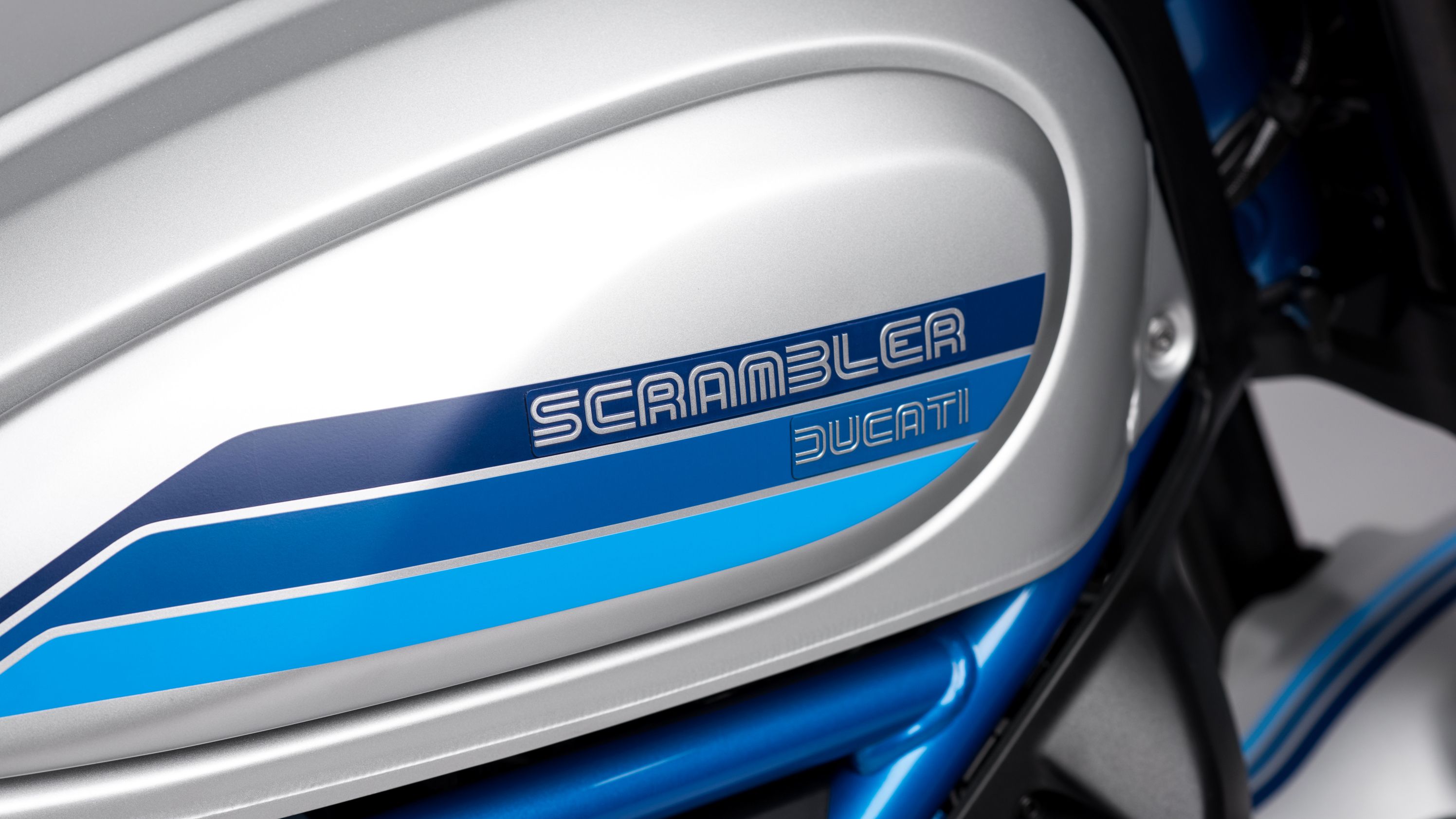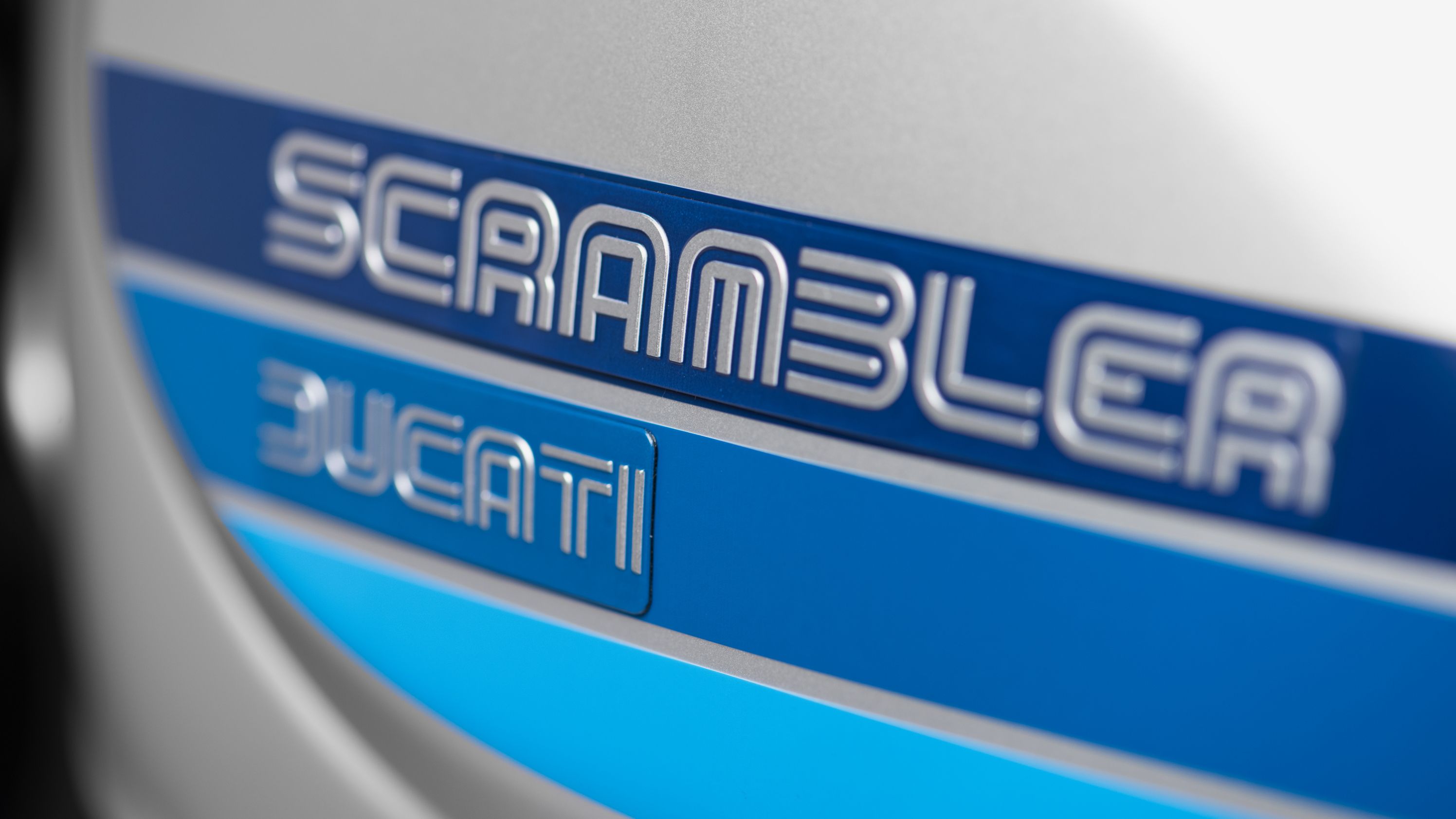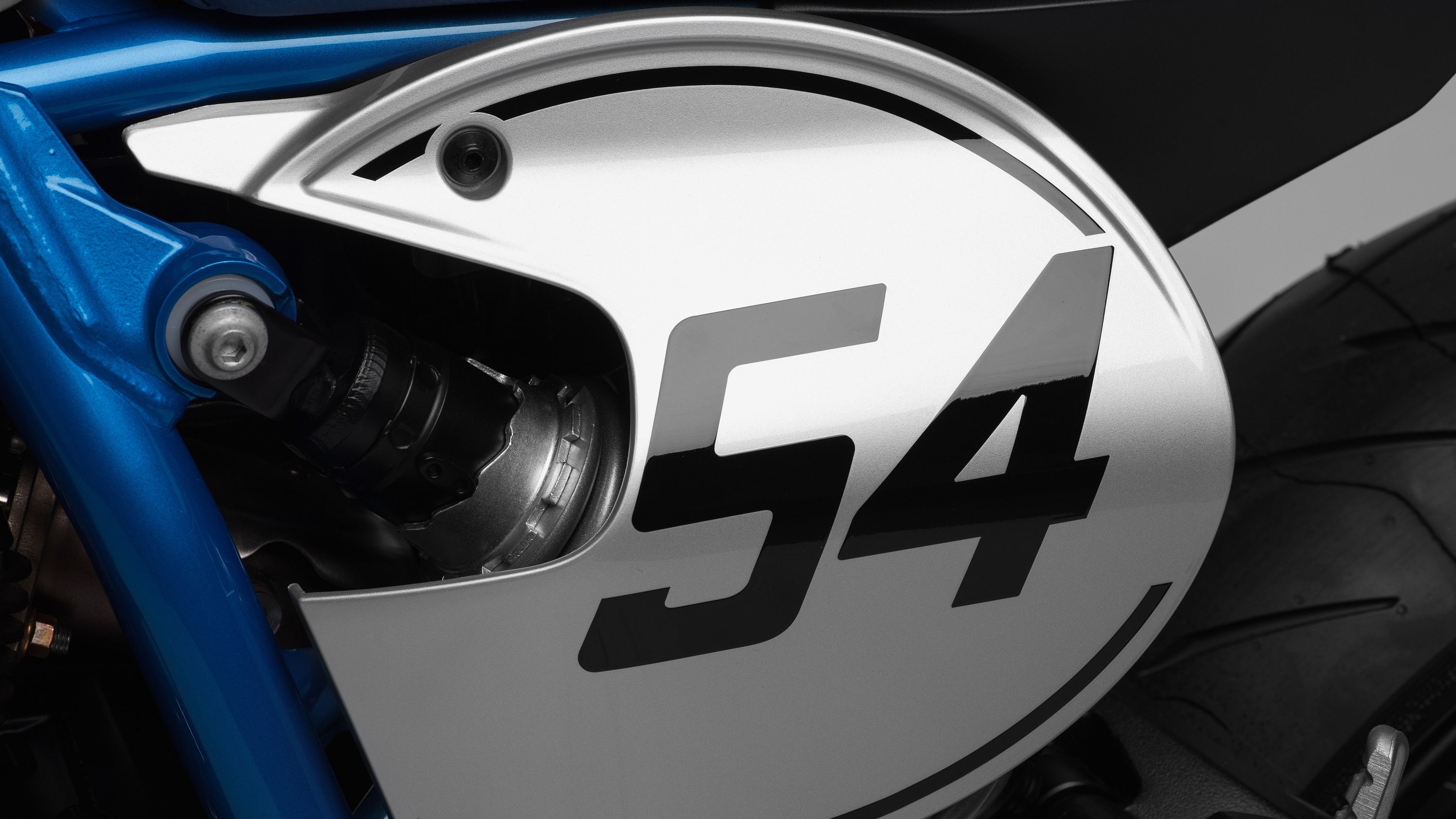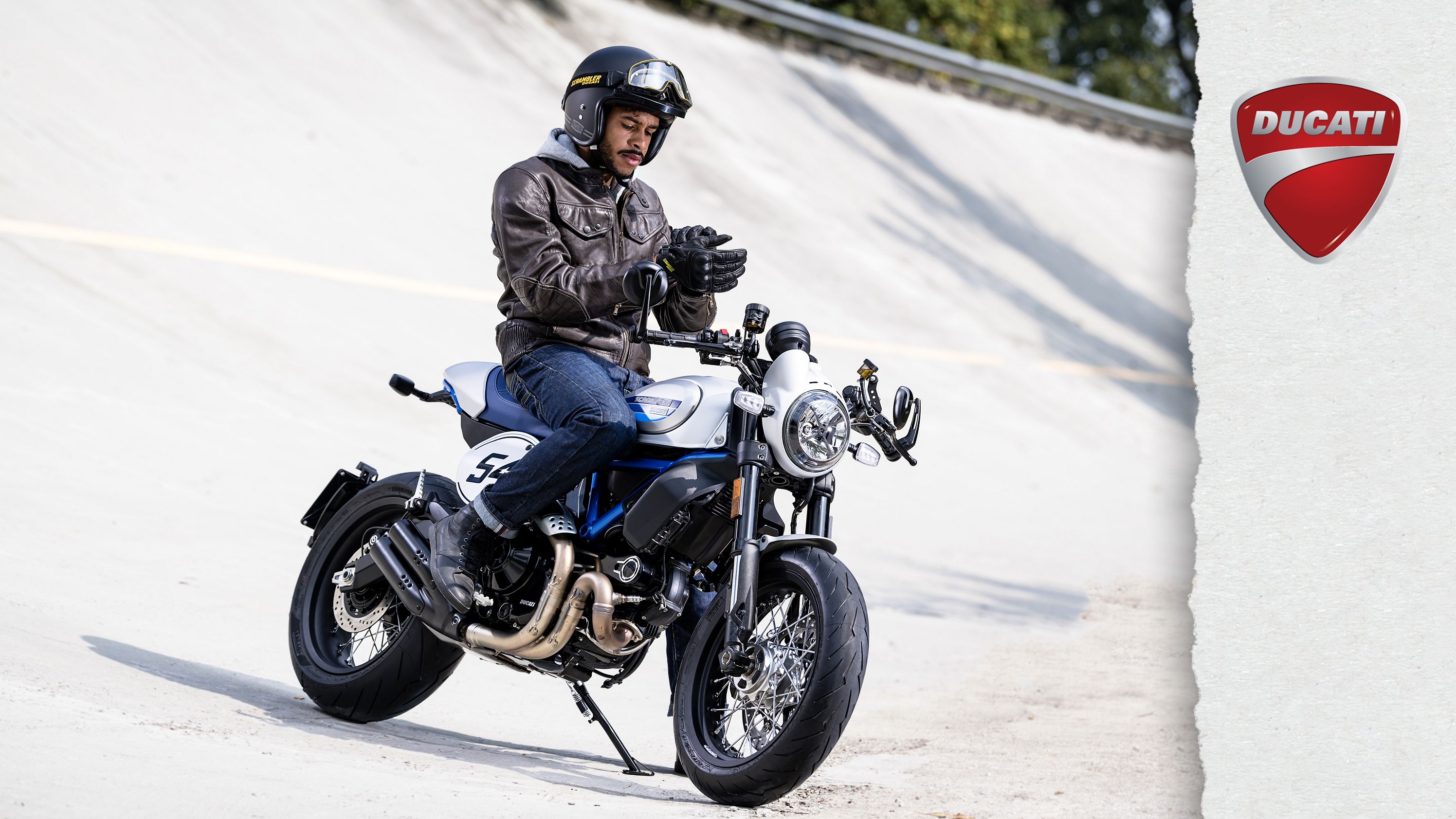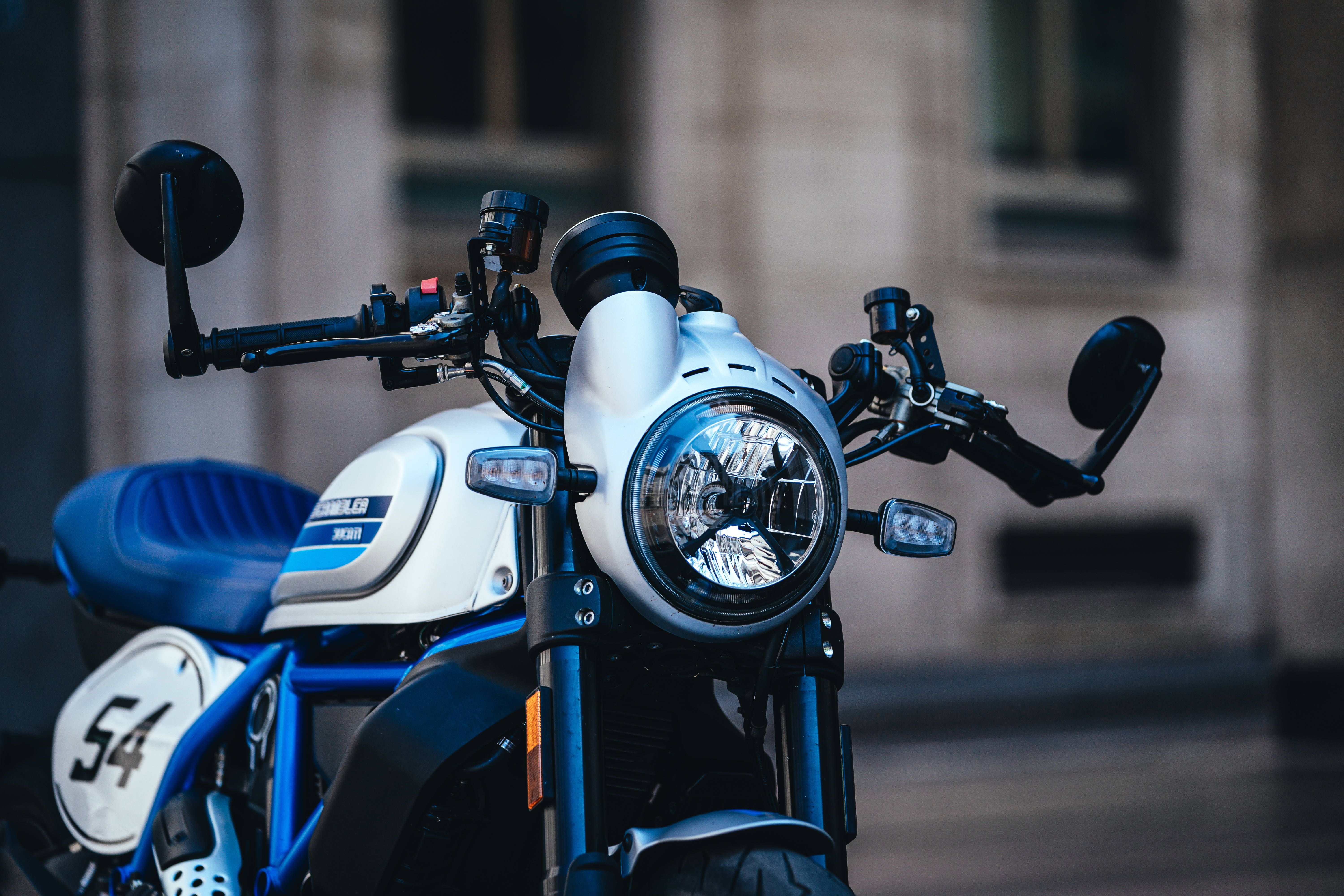Ducati refined its Scrambler lineup ahead of MY2019, and the Café Racer benefits from a number of improvements. New graphics, a new seat, and old-school laced wheels buff curb appeal, but it ain't all about the vanity. The factory upgraded rideability and safety as well. In other words, Duc took one of its best mid-size rides and made it even better.
2019 - 2020 Ducati Scrambler Café Racer
- Make: Array
- Model: 2019 - 2020 Ducati Scrambler Café Racer
- Engine/Motor: L-Twin
- [do not use] Vehicle Model: Array
Ducati Scrambler Cafe Racer Design
The development arc for the Scrambler line has been rather steep, and that's especially true of the “Café Racer.” It first saw light of day in '17 -- just a couple of years after the reintroduction of the family -- and after a short time on the market, it's already rolling out with its first major upgrade.
It starts out with a cool new paint scheme the factory calls “Silver Ice Matt,” and as the devilishly clever name suggests, it's rockin' a silver finish on all the sheet metal/plastic/whatever with a series of seventies-tastic stripes in varying shades of blue to go with the hue on the exposed Trellis skeleton. The café vibe is strong with this one due to the small speedscreen around the LED headlight and the tail fairing that is actually a cover hiding the pillion pad. A number plate and bar-end mirrors complete the ensemble for another not-so-subtle connection to the trackside café culture, and I gotta' say that although the features are kinda' subtle, the factory was more faithful to the genre than many on the market right now.
Many of the early café racers were customs/homejobs, so the ample blackout treatment and heavily bobbed front fender play right into that theme, and the new aluminum handlebar kinda' mimics the look of the originals that were, in many cases, the stock bars turned upside-down and backwards. So, unlike those forebears, the 3.57-gallon teardrop tank won't be sporting the characteristic tank dings frequently associated with the genre.
The tank shape gives the flyline a nice long slope down to the blue tuck-and-roll saddle sporting a shallow butt-bucket that will no doubt be a comfort if/when you get a bit twisty with it. Tucked up under the tip of the tail is an LED taillight braced by a pair of turn signals for a clean finish. The tag is mounted to the hugger that, although it isn't part of the old-school ensemble, is nevertheless a good hit that just looks really cool and makes its own contribution to the uncluttered rear end.
Ducati Scrambler Cafe Racer Chassis
Tubular steel members make up the Trellis frame on the Scrambler Café Racer that does almost as much for the look as it does for support. It's obviously an abbreviated structure that relies on the engine as a stressed unit to complete the assembly and give the bike its final rigidity. This leaves the bike looking like it's wrapped around the engine, rather than looking like the engine is stuffed into the bike, and since the air-cooled mill is proffered like that, it gets plenty of exposure to the incoming air stream to efficiently dump its waste heat.
The steering head is set for 21.8 degrees of rake with all-around 17-inch, laced aluminum wheels that land on 3.7 inches of trail over a 56.5-inch wheelbase. If you're thinking that those are some pretty nimble numbers, you are correct, and that's perfectly in keeping with the early café racers that were, essentially, stoplight burners meant for everyday urban roads.
Brute power is fine and dandy, but the CR always has been more of a finesse machine that favors curvy roads and bold riders rather than relying on acceleration in the straights to be effective. That said, you aren't likely to be dragging a knee on this thing, but you'll get close enough for a decent thrill if you have the stones for it.
A pair of inverted KYB forks float the front end on fixed values with a Kayaba monoshock out back that comes with the obligatory spring-preload adjustment, but nothing else in the way of rideability tweaks. The laced wheels certainly add some old-school charm to be sure, but the rubber is entirely modern with Pirelli's Diablo Rosso III hoops to round out the rolling chassis.
Brembo supplies the anchors with a four-piston, radial-mount caliper and massive, 330 mm front disc, opposite a single-pot caliper and 245 mm disc out back. New for this year, the ABS comes from Bosch, and it reads data from the six-axis inertial-measurement unit to deliver corner-sensitive antilock protection. That's some top-shelf stuff right there that increases the value significantly all by itself.
|
Frame: |
Tubular steel Trellis frame |
|
Front suspension: |
Upside down Kayaba 41 mm fork |
|
Rear suspension: |
Kayaba rear shock, pre-load adjustable |
|
Rake: |
21.8° |
|
Trail: |
3.7 in (93.9 mm) |
|
Total steering lock: |
35° |
|
Front wheel: |
Spoked aluminum wheel 3.50" x 17" |
|
Rear wheel: |
Spoked aluminum wheel 5.50" x 17" |
|
Front tire: |
Pirelli Diablo Rosso III - 120/70 R17 |
|
Rear tire: |
Pirelli Diablo Rosso III - 180/55 R17 |
|
Wheel travel, front/rear: |
150 mm (5.9 in) / 150 mm (5.9 in) |
|
Front brake: |
Ø330 mm disc, radial 4-piston caliper with Bosch Cornering ABS as standard equipment |
|
Rear brake: |
Ø245 mm disc, 1-piston floating caliper with Bosch Cornering ABS as standard equipment |
Ducati Scrambler Cafe Racer Drivetrain
The L-Twin mill -- or 90-degree V-twin if you like – on the Scrambler Café Racer runs with only a pair of poppets in each head. It's a Desmodromic-type valvetrain that uses a pull-closed cam rather than coil springs to close the valves, and this pays off at higher revs when sprung engines would start to get harmonic valve float and lose power at best, or contact the piston crown at worst. Yeah, there's a lot to be said for an engine that won't turn into a boat anchor the first time you miss a shift (badly) and over-rev the thing (also badly).
The oversquare layout runs with 88 mm bores and a 66 mm stroke to make up the 803 cc displacement, and compression is in the upper midrange at 11-to-1. Aspiration control falls to a 50 mm throttle body, but the signal is pure vanilla with nothing in the way of modification from traction control, rider modes, and the like.
What does this get you? Well, the CR claims a total of 73 ponies at 8,250 rpm and 49 pound-feet at 5,750. The plant meets Euro 4 emissions standards, mainly due to the efforts of the catalytic converter as well as the Lambda probes that help the computer keep the stoichiometric ratio dialed in.
A hydraulic clutch control comes with an adjustable lever that lets you dial in for your hand size. The slip-and-assist clutch gives you a bit of backtorque prevention to protect the rear contact patch on hard downshifts and engine braking. The gearbox itself is a six-speed unit, and the power heads to the rear wheel via a tough chain drive to finish off the running gear.
|
Engine: |
L-Twin, Desmodromic distribution, 2 valves per cylinder, air cooled |
|
Displacement: |
803 cc |
|
Bore x stroke : |
88 mm x 66 mm |
|
Compression ratio : |
11:1 |
|
Power : |
73 hp (54 kW) 8,250 rpm |
|
Torque : |
49 lb-ft (67 Nm) @ 5,750 rpm |
|
Fuel injection: |
Electronic fuel injection, 50 mm throttle body |
|
Exhaust: |
Stainless steel muffler with catalytic converter and 2 lambda probes, aluminum tail pipes |
|
Gearbox: |
6 speed |
|
Ratio: |
1=32/13 2=30/18 3=28/21 4=26/23 5=22/22 6=24/26 |
|
Primary drive: |
Straight cut gears, Ratio 1.85:1 |
|
Final drive: |
Chain, front sprocket 15, rear sprocket 46 |
|
Clutch: |
Hydraulically controlled slipper and self-servo wet multiplate clutch |
Ducati Scrambler Cafe Racer Pricing
MSRP for 2020 is $11,995 for the updated Scrambler Café Racer. It comes with a choice of three warranty packages that cap with a 24 month/unlimited mileage plan.
|
Standard equipment: |
Steel tank with interchangeable aluminum side panels, headlight with DRL by LED light-guide and interchangeable aluminum cover, LED rear light with diffusion-light, LED turn indicator, LCD instruments with gear and fuel level indications and interchangeable aluminum cover, under-seat storage compartment with USB socket, ABS cornering, machine-finished aluminum belt covers, black engine with brushed fins |
|
Café Racer equipment: |
Clip on handlebars, aluminum handelbars mirrors, sports style front mudguard, dedicated side number plate, "café racer" seat with passenger seat cover, spoked aluminum wheels |
|
Warranty: |
24 months unlimited mileage |
|
Color: |
Silver Ice Matt |
|
Price: |
$11,995 |
Ducati Scrambler Cafe Racer Competitors
For my head-to-head, I grabbed one of Triumph's machines; the Street Cup. No, it isn't explicitly labeled a café racer, but I assure you, it's a modern café in everything but name. You can see it in the flyscreen ahead of the dead-short bars and at the tail cover that hides the p-pad for the solo-racer look that tidies up the rear end quite nicely.
Of course, the parallel-twin plant reinforces that old school Trumpet café look even though it's actually liquid cooled, but the radiator is very inconspicuous against the liberal blackout treatment, I must say. The blackout also ties into the custom culture for a little lagniappe charm and historical depth, though Triumph certainly has deep enough roots to be able to draw on its own experience, much the same as Ducati, so this is definitely a battle of the giants.
Looks aside, Trumpet hits the ground running with RbW throttle control, switchable TC, ABS and a slipper clutch, so it's packing some extra fandanglery that the CR just can't touch. I'll leave it to you to decide if it's worth losing the traction control in order to gain the lean-sensitive ABS.
Trumpet powers the Street Cup with its 900 cc Bonneville engine for a slight edge in cubeage but the difference in engine layout camouflages any potential advantage as the Bonneville plant claims 55 horsepower and 59 pound-feet of grunt against 73/49 from the Duc. Ducati comes off looking a bit prouder at the checkout against the $10,500 Street Cup.
He Said
“Is it worth the extra money? I'll give you a definite “probably,” though my personal bias is kicking in here, and I prefer the Brit. If I'm honest, a lot of that comes down to looks, and yes, I am exactly that shallow because at the end of the day, you want to feel a connection with your machine, and that comes down to personal taste.”
She Said
My wife and fellow motorcycle writer, Allyn Hinton, says, “So what's different about the Café Racer that sets it apart from the other Ducati Scramblers, aside, of course, from the eye-catching graphics? It has 17-inch wheels front and back as well as aluminum clip-ons, sports style front mudguard, and a café-style p-pad cover that all lend to the café look. It's Ducati Multimedia System ready, and new-from-last-year, it comes with Bosch cornering ABS.The new colorway comes from the legendary Ducati 125GP Desmo and the '54' number plate honors Bruno Spiaggiari, former Grand Prix racer and later Ducati Desmo team manager.”
Ducati Scrambler Cafe Racer Specifications
|
Engine & Drivetrain: |
|
|
Engine: |
L-Twin, Desmodromic distribution, 2 valves per cylinder, air cooled |
|
Displacement: |
803 cc |
|
Bore x stroke : |
88 mm x 66 mm |
|
Compression ratio : |
11:1 |
|
Power : |
73 hp (54 kW) 8,250 rpm |
|
Torque : |
49 lb-ft (67 Nm) @ 5,750 rpm |
|
Fuel injection: |
Electronic fuel injection, 50 mm throttle body |
|
Exhaust: |
Stainless steel muffler with catalytic converter and 2 lambda probes, aluminum tail pipes |
|
Gearbox: |
6 speed |
|
Ratio: |
1=32/13 2=30/18 3=28/21 4=26/23 5=22/22 6=24/26 |
|
Primary drive: |
Straight cut gears, Ratio 1.85:1 |
|
Final drive: |
Chain, front sprocket 15, rear sprocket 46 |
|
Clutch: |
Hydraulically controlled slipper and self-servo wet multiplate clutch |
|
Chassis: |
|
|
Frame: |
Tubular steel Trellis frame |
|
Front suspension: |
Upside down Kayaba 41 mm fork |
|
Rear suspension: |
Kayaba rear shock, pre-load adjustable |
|
Rake: |
21.8° |
|
Trail: |
3.7 in (93.9 mm) |
|
Total steering lock: |
35° |
|
Front wheel: |
Spoked aluminum wheel 3.50" x 17" |
|
Rear wheel: |
Spoked aluminum wheel 5.50" x 17" |
|
Front tire: |
Pirelli Diablo Rosso III - 120/70 R17 |
|
Rear tire: |
Pirelli Diablo Rosso III - 180/55 R17 |
|
Wheel travel, front/rear: |
150 mm (5.9 in) / 150 mm (5.9 in) |
|
Front brake: |
Ø330 mm disc, radial 4-piston caliper with Bosch Cornering ABS |
|
Rear brake: |
Ø245 mm disc, 1-piston floating caliper with Bosch Cornering ABS |
|
Dimensions & Capacities: |
|
|
Wheelbase: |
56.5 in (1,436 mm) |
|
Dry weight: |
396.8 lb (180 kg) |
|
Wet weight: |
432 lb (196 kg) |
|
Seat height: |
31.7 in (805 mm) |
|
Max height: |
41 in (1,066 mm) (brake reservoir) |
|
Max width: |
34.5 in (875 mm) |
|
Max length: |
82.3 – 85.0 in (2,090 – 2,160 mm) (with options) |
|
Number of seats: |
Dual seat |
|
Fuel tank capacity: |
3.57 gallon (13.5 l) |
|
Fuel Economy: |
46 mpg (5.1 l/100 km) |
|
Top Speed: |
125 mph (est) |
|
Details: |
|
|
Standard equipment: |
Steel tank with interchangeable aluminum side panels, headlight with DRL by LED light-guide and interchangeable aluminum cover, LED rear light with diffusion-light, LED turn indicator, LCD instruments with gear and fuel level indications and interchangeable aluminum cover, under-seat storage compartment with USB socket, ABS cornering, machine-finished aluminum belt covers, black engine with brushed fins |
|
Café Racer equipment: |
Clip on handlebars, aluminum handelbars mirrors, sports style front mudguard, dedicated side number plate, "café racer" seat with passenger seat cover, spoked aluminum wheels |
|
Warranty: |
24 months unlimited mileage |
|
Color: |
Silver Ice Matt |
|
Price: |
$11,995 |
Further Reading
Triumph Bonneville Street Cup
See our review of the Triumph Bonneville Street Cup.
Ducati
Read more Ducati news.

